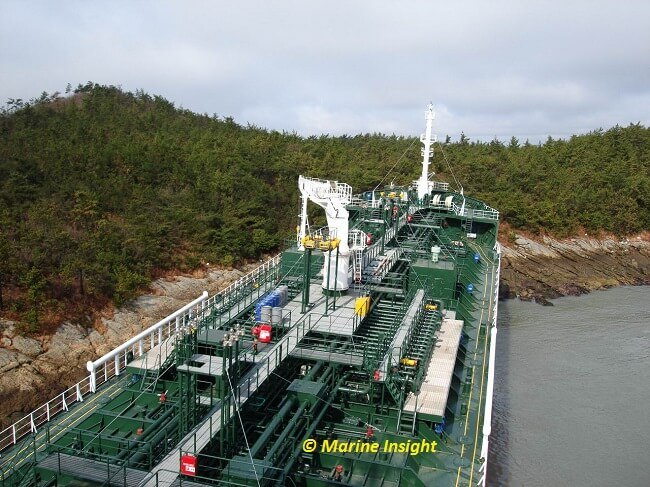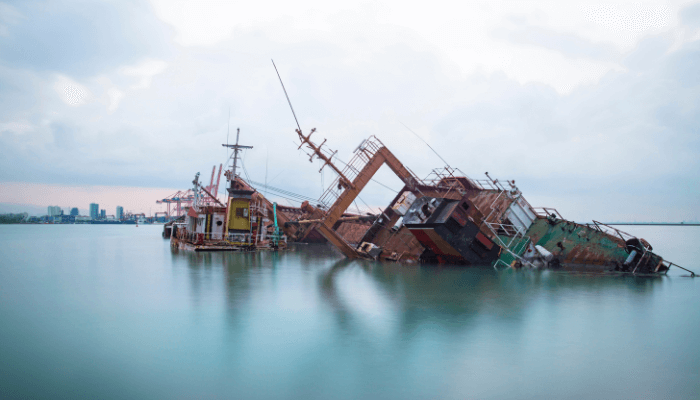

The sinking of a vessel or capsizing is the worst thing for anyone working in the maritime sector. The offshore shipping industry is replete with challenges and hazards, and risks. Many mariners and sailors lost their lives in such accidents every year. These devastating incidents may also cause injuries, illnesses, drowning of crew and death from hypothermia or falls.
As a maritime professional, one must know his rights and duties. The employer or the shipping company is responsible for taking precautionary measures to prevent ships from sinking and capsizing.
It means maintaining and repairing ships and carrying regular inspections, so the vessel is sea-worthy. The crew members should be adequately trained. If a sailor is injured or lost a loved one or a colleague in such an accident, their families have the right to compensation if the company or any other worker is found to be at fault.
Ship capsizing occurs when a vessel at sea lists to one side to such an extent that it cannot regain its original position, making it unsafe for the crew and machinery onboard.
Deadly accidents reported by media and news highlight that even modern ships can capsize in certain conditions. Though it seems quite unbelievable that such engineering marvels could be defeated, there are many reasons for this. Most times, ships capsize due to human error and negligence. Sometimes bad weather and thunderstorms may result in a vessel losing its stability.
In this article, we will discuss various reasons leading to the capsizing of a commercial ship and precautions to avoid the same.
Large free surface, a result of slack tanks and improper subdivisions of tanks (no longitudinal divisions), results in the reduction of the metacentric height and increases the possibility of capsizing, especially if GM (metacentric) is less( Ro-Ro vessel).
Certain tanker vessels designed with no longitudinal bulkhead in the cargo tank are more prone to capsizing because of the significant free surface effect, especially when the ship is heavily loaded in harsh weather, which allows a large amount of water to come on deck. In such cases, if adequate drainage is not provided, the possibility of capsizing increases drastically.
Shifting cargo on the ship can result in the heavy lifting of the ship, which increases progressive rolling and thus the possibility of the vessel capsizing.
Proper securing of cargo is necessary. This can also be avoided by suitable ship design, for e g. The provision of hopper tanks in bulk carrier minimise the shift of cargo.
Some types of bulk cargo are susceptible to absorbing moisture (hygroscopic nature). When moisture content rises above a specific limit, the dry cargo behaves like liquid cargo giving rise to a high free surface effect or shift of cargo, offering a dangerous list to the vessel and possible capsize.
A cargo ship may collide with other ships, piers, reefs and bridges in shallow waters. Proper navigation and piloting are necessary to prevent this situation. However, accidents can still happen, especially in busy ports and harbours. Such accidents also result in tremendous financial loss as a strong collision can crack the vessel’s hull.
If the vessel runs aground, specifically at a spot off the central line and subsequently if the water level drops, there is a virtual rise in the centre of gravity.


This may make metacentric height negative, resulting in vessel capsizing. For this reason, adequate vigilance is required to ensure no grounding.
Any flooding due to external or internal reasons will result in loss of buoyancy of the ship. The vessel will capsize if this loss is more significant than the reserve buoyancy. Hence hull, watertight and weather-tight integrity and proper leakproof piping systems should be maintained at all times.


Any heavy weather damage that leads to progressive flooding will cause a loss of buoyancy. If this loss is greater than reserve buoyancy, the vessel will capsize.
Proper weather routing is to be done to avoid heavy weather.
While fighting the fire using fire pumps on ships, especially at higher decks, there might be a substantial addition of weight raising ‘G’ centre of gravity and reduction of GM, leading to possible capsize. This point is to be noted while fighting a fire.
Every vessel has a natural rolling period which is inversely proportional to the square root of the metacentric height and directly proportional to the ship’s beam.
If the vessel encounters a series of swells such that the wave period matches the rolling, the ship will have no time for righting itself before the next wave strikes. If not corrected, this situation can result in the vessel’s capsizing. The speed and direction of the ship can be checked and altered as necessary to avoid the ill effect of synchronous rolling.
A ship may capsize for all the reasons mentioned above; however, many of these can be avoided by taking certain precautions. The crew must be extra vigilant when sailing through rough weather and stormy seas and carry out frequent ship inspections to ensure there are no leakages or problems in any machinery.
Collisions can be avoided with careful navigation. Often miscommunication between captains and crew causes accidents. This should be taken care of, and everyone should be delegated tasks beforehand to avoid confusion and misunderstandings in a crisis.
Shifting cargo becomes a problem only when not stored and secured correctly. Hence, it should be secured in place before sailing. Flooding can be easily avoided if vessels are repaired regularly and have workable emergency equipment that detects leaks.
We can conclude that most ships capsize due to human negligence and error. Though rough weather and poor visibility resulting from thick fog might be a reason, such situations are often not the actual cause of accidents.
The MV Golden Ray was a 200 m long RORO ship. It was carrying over 4100 cars when it capsized on 8th September 2019 in Saint Simons Sound, close to the port of Brunswick, Georgia. The ship was destined for Baltimore.
According to the NTSB report, it sank due to inaccurate stability calculations. The chief officer had entered the wrong ballast quantities. It was also found that two watertight doors were open, which flooded the ship after it capsized. A search effort followed, and all crew, including the engineers, were rescued by coast guard crews.
It was declared a total loss and removed from the sea in pieces. The ship was carrying worth 142 million dollars worth of cargo that went down with it due to human error.
Seacor power, owned by Seacor Marine, was an offshore oilfield vessel that capsized in hurricane-force winds in April 2021. Extensive search operations over hundreds of square miles, using helicopters and coast guard boats, were carried out to find crew members.
The bulky vessel overturned in the Gulf of Mexico. The winds were over 90 mph, and the waves reached 8 to 9 feet when the ship sank.
It was called a jack-up rig due to its three long legs that lower to the sea floor to lift the boats, as an offshore platform, drowned south of Port Fourchon, a major base of the US oil and gas industry. It was bound for Main Pass near the southeastern Louisiana coast. As per the National Weather Service, it flipped over during a microburst. Hence, meteorologist Benjamin Schott suggested that the weather phenomenon played a crucial role in its capsizing.
Flooding due to internal or external reasons will lead to a loss of buoyancy of the vessel. The ship will capsize if such a loss exceeds the reserve buoyancy. So, hull, watertight and weathertight integrity, including appropriate leakproof piping system, should always be maintained.
Usually, strong winds can push the vessel to one side. However, it does not topple over. A ship keeps upright because all the heavy equipment is kept below the deck. It keeps a low centre of gravity; the lower the centre of gravity, the more stable a vessel is.
One must be extremely careful while getting out of a capsized boat. Firstly, wear life jackets or get on a life raft. If you cannot do so, try to hold anything and keep floating till help arrives.
Capsizing is a consequence of overloading, inappropriate anchoring, unsafe handling, lack of vessel maintenance, bad weather, loss of power or machinery failure onboard.
Ships have powerful engines that steer them forward without being tossed with the flow of waves. Hence, a vessel should always keep its bow pointing to the waves to pass through them safely.
You might also like to read.
Disclaimer: The author’s views expressed in this article do not necessarily reflect the views of The Marine Learners. Data and charts, if used in the article, have been sourced from available information and have not been authenticated by any statutory authority. The author and The Marine Learners do not claim it to be accurate nor accept any responsibility for the same. The views constitute only the opinions and do not constitute any guidelines or recommendations on any course of action to be followed by the reader.
The article or images cannot be reproduced, copied, shared, or used in any form without the permission of the author and The Marine Learners.










We believe that knowledge is power, and we’re committed to empowering our readers with the information and resources they need to succeed in the merchant navy industry.
Whether you’re looking for advice on career planning, news and analysis, or just want to connect with other aspiring merchant navy applicants, The Marine Learners is the place to be.